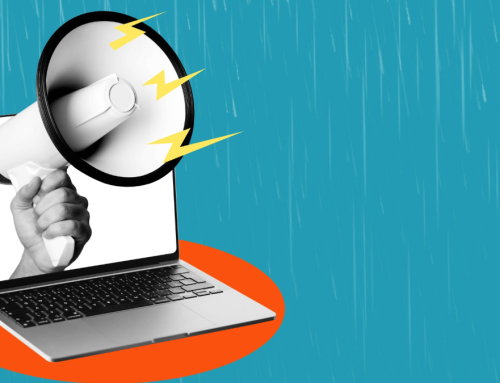Any way you look at it, 2020 has been tough.
Many businesses had to rapidly pivot in order to stay afloat amid global shutdowns to limit the spread of COVID-19, while many others weren’t so lucky, and were forced to close forever as a result. We’ve learned to work from home, navigating our daily tasks amid home-school and other distractions, and find new forms of entertainment to keep each other occupied. And this is all before you factor in the ongoing political turmoil, and the uncertainty around what comes next.
2020 is a year that many would rather forget, and in amongst all this, the major social platforms have also rapidly evolved and shifted focus in order to meet rising demand and user needs during the pandemic.
That’s accelerated many of their plans, but for the most part, the new tools and options introduced were already in development. Indeed, many of our predictions for 2020 were pretty spot on, and based on current trends, and where the social platforms are headed, we’ve put together a new collection of predictions for 2021, and what social media marketers should be preparing for as they map out their plans.
And all going well, it looks set to be a year of growth, and exciting developments. Here are our platform-by-platform predictions for what’s coming next in the world of social media marketing, starting with the blue behemoth, Zuckerberg’s ever-expanding social empire.
Facebook has once again seen a year of many challenges, and has once again come through them in a stronger position than where it began. That’s despite rising backlash over the role the platform has played in exacerbating political division, and amplifying hate speech, and amid a push for a break-up of the company over its anti-competitive behavior.
Yet, despite an ad boycott, a critical Netflix documentary, and the forced removal of certain concerning groups, Facebook marches on, and 2021 looks set to see some major developments aligned with the next stage of The Social Network.
The New Storefront
eCommerce will be a major focus for Facebook in the next year.
We’ve already seen the first stages of Facebook’s next big revenue push, with the introduction of Shops on Facebook and Instagram, which simplifies the process of building an eCommerce outlet on the world’s most used digital platform.
That will give every business the chance to quickly build their own digital storefront, with helpful, familiar presentation options and streamlined payment tools, fueling a new wave of online business.
For Facebook, this has been years in the making, with Shops essentially being an extension of its Marketplace offering, giving more businesses the chance to connect with buyers in-stream. But Shops is also much more than that.
The big focus here will be in markets like India and Indonesia, where Facebook is seeing rapid user growth, and where the digital shift is only really beginning. If Facebook can get in on the ground floor, and become the destination for all forms of online transactions, that could see the company become an essential platform in developing regions, expanding opportunities, both for Facebook and businesses around the world, to maximize their potential.
Expect to see further development of Facebook Pay as The Social Network looks to simplify its one-click purchasing options, and new advertising opportunities that highlight products for purchase within posts. Facebook will also look to integrate more shopping posts into user feeds, in order to entice more shopping activity, while the likely merger of its messaging apps will also provide more opportunity to facilitate eCommerce across its tools.
If Facebook can get it right, this could be a major shift, fueling a new wave of eCommerce activity – which is why looking further into Facebook Shops should be a key priority for retail providers.
Also look for further development of live-stream promotion and purchasing options, and new eCommerce integrations within Watch exclusive programs as Facebook looks to tie everything back into its transactional options.
Messaging Merger
Yes, Facebook is still working on the merger of its messaging apps, and throughout the year we’ve seen more and more hints of the gradual interconnectivity of Messenger, Instagram Direct and WhatsApp.
That, essentially, means that every new function introduced in any one of these apps will eventually be available in the other two – which will also facilitate new eCommerce opportunities, and more ways to run cross-platform ad campaigns and pushes in order to expand your opportunities.
Eventually, that will make it very easy for brands to expand their campaigns and functions across to, say, WhatsApp, broadening their audience potential in ways that hadn’t previously considered. That’ll become a bigger opportunity as Facebook showcases how that interoperability works, and what will be possible as a result.
Regulators in several nations have voiced their opposition to Facebook’s messaging integration plan, and it is still contingent on no further regulatory action being taken. But it seems to be well on the way now, and that will open up new potential for connection with your potential customers across Facebook’s DM tools.
AR Glasses
Back in September, Facebook announced that its ‘Project Aria’ wearable AR glasses would likely be available in 2021, and while that won’t mean they’ll be here come January 1st, you can expect to see the glasses hitting retail stores in the second half of the year.
AR is set to become a key battleground in the tech sector, with Apple also working on its own AR glasses, which are set for release around the same time.
This will be a key development for Facebook. It now has solid experience in consumer products, with sales of both its Portal and Oculus devices rising significantly in 2020, and it’s in a good position to bring the first functional, fashionable AR glasses to market, teaming up with EssilorLuxottica, the makers of Ray-Ban, to build the device.
Facebook has been working towards this for years, with the development of fully immersive AR environments, and the capacity to incorporate new ad types, promotions, informational cues and more, all linking back into its main app.
There are many implications, and potential applications, here, and Facebook will also be looking to use its AR glasses as a stepping stone to the next stage of digital connection, which leads us to…
The Rise of VR
As noted, Facebook’s Oculus virtual reality headsets have seen a major sales boost in 2020. With all of our regular entertainment options shut down, many have been seeking new ways to keep ourselves occupied, and VR has fit the bill for those who can afford to take the leap.
But that ‘leap’ is getting smaller – as you can see, Facebook has gradually been lowering the price of its standalone VR devices, making it a more accessible option, which has also helped boost take-up.
And that’s a good approach for The Social Network – as Facebook adds more VR users, it also opens up new avenues for advertising and promotion, and leads more consumers into the next stage of digital connection, meeting up within fully immersive environments online.
VR also has applications beyond entertainment, with many businesses also finding new ways to conduct key operations within the simulated space.
With the WFH shift expected to see ongoing momentum, now that people and businesses know what’s possible, this could further increase the take-up of VR, which will see new opportunities, in many ways, to connect with various audiences.
Algorithm Shifts
One of the big questions for Facebook will be how it addresses concerns about its notorious feed algorithm, and whether it does anything to address concerns that it’s fueled the rise of dangerous hate speech.
Facebook has already taken some action on this, banning QAnon and various related groups, which it had allowed to proliferate on its platforms for years, despite expert warnings. But under a Biden-lead US Government, it may have to take even more action, and further restrict misinformation and hate speech in order to avoid increased pressure, and penalties, imposed by Government and regulatory groups.
Facebook can do this. The New York Times reported recently that, in the days following the US election, Facebook implemented a News Feed tweak which ensured that “authoritative news appeared more prominently”, while downgrading the reach of some more fringe and/or centrist sites.
As explained by NYT:
“[The change] resulted in a spike in visibility for big, mainstream publishers like CNN, The New York Times and NPR, while posts from highly engaged hyperpartisan pages, such as Breitbart and Occupy Democrats, became less visible, the employees said. It was a vision of what a calmer, less divisive Facebook might look like. Some employees argued the change should become permanent, even if it was unclear how that might affect the amount of time people spent on Facebook. In an employee meeting the week after the election, workers asked whether the “nicer news feed” could stay, said two people who attended.”
As Facebook looks to more actively lobby US Senators, in order to facilitate its own growth agenda, it will need to give a little to get back, and that may well see the ‘nicer’ News Feed option gain traction, which could have a big impact on the platform more broadly.
That could see engagement on Facebook reduce – but maybe, if it can offset that with an increase eCommerce activity, Facebook will be able to appease both elements without losing out.
Of course, any such move also won’t please extremist groups. But it could be a step in the right direction to reduce societal division more generally.
Even after all these years, it’s still difficult to say what Twitter is, what its key strengths are, and where it will look to grow in future. Because despite the platform’s ongoing popularity, Twitter is largely unchanged, with no major innovation or updates that have altered how people use the app.
Sure, it made tweets longer back in 2018, and it’s tried out live-streaming and Moments and audio tweets, among various other options. But none of them have really caught on, and Twitter, for the most part, remains what it was at its beginning – a real-time stream of short, sharp updates, great for staying up with the latest info. Not so good for much else.
So how can Twitter evolve beyond this? It’s probably safe to say that we’re not going to see any major change over the course of the next 12 months.
Fleets Updates
Twitter’s own version of Stories – ‘Fleets’ – is now available to all users, and over the next year, you can expect Twitter to roll out new updates for the option as it looks to tap into the rising popularity of the format.
The notable omissions from Fleets are AR options and effects, and it seems likely that Twitter will add various tools on these fronts, assisted by its acquisition of Chroma Labs back in February. But many of these additions will be behind time – people already have a range of effects and visual tools on Snapchat, Instagram and TikTok, and it would be unlikely for Twitter to surpass those and make Fleets a bigger consideration in this respect.
Fleets will stick around, and some people will use it, but it doesn’t seem like it’s going to become a major element of the Twitter experience.
It’s an interesting add-on, no doubt, but Fleets won’t drive a significant uptick in usage or interest in the app.
Audio Spaces
Twitter’s also working on Audio Spaces, which will be a Clubhouse-like, audio meet-up feature, giving users another way to interact.
Which, like audio tweets, will be interesting for a bit, but again, it’s unlikely to become a transformative feature in the app.
Of course, it doesn’t have to be to provide functional value, but Audio Spaces still seems limited, even with low expectations. Still, it’ll be something to experiment with, and given recent developments, it looks set to be available in early 2021.
Topic Focus
Twitter’s also been looking to expand its potential for engagement by providing users with more recommendations of Topics to follow in their feeds, as opposed to profiles.
In 2021, it wouldn’t be surprising to see Twitter take this a step further and add Topic spaces, where it will collect relevant tweets on a topic, curated by Twitter’s team, into a dedicated page or section in the app.
This could be similar to its current listings related to in-progress sporting events and live-streams, providing a more immersive, focused listing of key tweets and profiles on each topic, which could help to improve engagement.
Status Indicators on Profiles
Twitter’s been testing these for a while, and it seems like a logical addition, especially in line with the roll-out of Fleets.
It’s not a major element, but it could provide more opportunity for connection and engagement, especially around major events.
Expect to see these arrive in the first half of next year.
Verification Categories
Last week, Twitter explaind that it’s working on new categories of verification, beyond just the basic blue tick. That could see new types of verified accounts, which could include specific indicators based on what each represents.
The major addition here could be a new identifier for bot accounts – in October last year, Twitter said that it was working on a possible identifier for bot profiles, in order to let users know who (or what) they’re dealing with.
That could be a big change, which could change engagement in the app. And if Twitter wanted to take it a step further…
Bot Crackdown
Bots remain a major problem on Twitter, with various political trends attributed to bot ‘armies’ that are utilized to manipulate engagement and sway opinion.
But what if, as part of its new bot verification process, Twitter established a threshold on what qualifies as a bot account. What if Twitter said, for example, that ‘if 80% of your tweets are retweets, you’ll be labeled as a bot profile’.
That would annoy a lot of users, but it might also get more users sharing more of their own thoughts, as opposed to simply amplifying existing comments. That would also be in line with Twitter’s more recent pushes to get users to take more time to consider what they’re sharing, as opposed to straight retweets.
There’s no indicator that Twitter will do anything like this, but it could be something to consider as it looks to tackle bot concerns.
Trump Gets Banned
This is a random prediction, but I’m tipping that at some point, around the middle of next year, Twitter will take the plunge and ban Donald Trump’s account outright.
Many have been calling on Twitter to take action on Trump’s account for years, and with the former President soon to be tweeting as a civilian, Twitter has already said that he’ll lose any special consideration or protections.
If Twitter wants to make a statement, as it did by banning political ads in late 2019, it could look to cut off Trump completely. Which would generate a lot of headlines – though the long-term impacts of benefits for the app may not be significant.
Instagram has become the next golden goose for Facebook, and the integration of new eCommerce tools looks set to take its earnings potential into a new stratosphere. But at the same time, some have suggested that the additions of IGTV, Reels and shopping have all started to clutter what was once a simple app focused on photography.
Of course, Instagram is well beyond its initial roots now, but has it gone too far – or will it, indeed, go over the edge in 2021?
In-stream shopping
eCommerce is obviously the big focus for Instagram, with a new Shop tab and dedicated features aligned with facilitating more immediate purchase behavior in response to IG posts.
Instagram will look to continue the development of its shopping tools in order to further encourage habitual shopping behavior – expect Instagram to add advanced one-click purchasing, new AR try-on tools, building on its existing AR shopping options (and potentially linked into Facebook’s AR glasses), and video tags for products, providing more ways for businesses and creators to facilitate direct buying.
Instagram is already where many people go to discover new products and brands, and its advanced shopping options could open up a whole range of new possibilities.
Sure, Reels got its own tab too, but shopping is where Instagram will make a real impact.
Variable home feed
This has been speculated for a while, but with the continued popularity of Stories, expect Instagram to try out a new approach to user home feeds in 2021, with some users set to open to a Stories feed, similar to TikTok’s home video stream.
That would mean that the main Instagram feed would lose focus, and become a secondary element. But I don’t expect Instagram to do this for everyone. Instead, what Instagram could try to do is to align the home feed with individual user preference, with the option to switch back if you choose.
For example, if you view Stories a lot, Instagram might switch you to a Stories-first home feed, with the option to go back to the regular post feed if you want. Some users might open to a Reels feed instead, some to the Shop tab. Rather than force all users into a new feed, Instagram could look to provide options, which may help boost engagement within each element.
Reels – good enough
Then there’s Reels, Instagram’s TikTok clone, which general consensus seems to suggest is interesting enough, but not as good as TikTok itself.
Will Reels stick around, and/or catch on with more users?
I don’t expect Reels to become a major element – and definitely not a TikTok killer of any kind. But it will likely find its own niche – and it’ll remain popular in India so long as TikTok remains banned in that region.
That could be enough to deem Reels a success, while Instagram will also look to further boost Reels through exclusive influencer deals and new features which could help it gain more traction at different stages. The right influencer deals could definitely help Reels boost engagement, and if TikTok doesn’t catch up on its revenue-sharing options, Reels will remain a competitive concern, adding more pressure to the app.
It seems unlikely that Reels will become a major consideration, but ‘good enough’ is likely all Instagram needs to justify its investment in the option.
Snapchat
Snapchat has continued to establish its own niche in 2020, especially with respect to its ongoing appeal among younger audiences. New app partnerships and interactive options have provided additional avenues of consideration, but AR remains the key to boosting the app’s appeal.
And despite having a more limited budget than the big players, Snap has remained a key innovator in the AR space – which could come up big in one specific way in the year ahead.
New approach to entertainment
One of Snapchat’s key areas of strength has been the steady growth of its Snap Originals programming, short, vertically-aligned TV-style shows that hold appeal to younger viewers and their evolving consumption habits.
Given this, expect to see Snap put more focus on Snap Originals in 2021 – and expect to see more major publishers and studios pay more attention, and look to align with the format, as they seek new ways to stay connected to younger audiences.
That could see some major announcements for Snap Originals, with big-name celebrities coming on board. And that will bring even more viewers to Snap, expanding its advertising and exposure opportunities.
eCommerce focus
As Instagram and Facebook look to incorporate more eCommerce tools, expect Snap to also align with this shift, and look to provide its creators with more opportunity to sell products direct in-stream.
Snapchat has been working on various eCommerce options for some time, including its integration with Amazon, but as in-feed shopping becomes more habitual, it makes sense for Snap to also incorporate similar tools, in order to maximize its own opportunities.
Advancing AR
As noted, AR remains key to maximizing Snapchat’s growth, and as such, you can expect to see Snap adding in more AR functionality and tools, as it looks to take its tools to the next stage.
Snapchat’s already started rolling out the capacity to ‘scan’ barcodes and labels in order to provide more contextual information through its camera, and it’ll look to keep adding to its database of scannable items, and connecting those scans to advanced AR tools, including promotions, offers, and more.
And that will lead to another key development…
Apple/Snap partnership
I’ve speculated this before, and I still think that Snapchat is working with Apple on the next stage of Apple’s AR glasses – which could potentially also lead to the next phase for its own Spectacles device.
Snapchat’s been working with Apple for years to help develop Apple’s AR functionality. Back in 2017, at the launch of the iPhone X, Apple explained how they’d been working with Snapchat to develop Lenses and visual additions based on the latest advancements in the device, while with the launch of the iPhone 12 earlier this year, Apple announced that Snap would be among the first partners for its new LiDAR capacity.
Apple’s AR glasses are set to be available by 2022, but may be pushed ahead dependent on Facebook’s efforts. And with that, I have no doubt that Snapchat will be working with Apple in some capacity.
Could we see the two partnering up to launch a new, AR-enabled version of Spectacles?
All of Snap’s AR developments would align with this, and that would be a major development for the company.
It remains speculative, but Apple-powered AR Spectacles could be a major shift, and could help Snapchat boost its presence, and tools, significantly, depending on how it plays out.
TikTok
TikTok has had a wild ride in 2020. The short-form video app has gone from 500 million users in December 2019 to close to a billion today, and despite facing bans, restrictions, accusations of censorship, undergoing national security reviews. Despite all of this, TikTok has continued to move forward, and now looks set to advance to the next level in 2021.
And it could be a key consideration for your digital marketing approach.
eCommerce focus
Like most other social platforms, TikTok will also be making eCommerce a focus in 2021 – though in TikTok’s case, it’s a little more pressing.
TikTok needs to find more ways to ensure its top creators get paid, otherwise they’ll drift off to other platforms where they can make real money. That’s what eventually lead to the demise of Vine – when its big stars realized they could be making a lot more on YouTube and Instagram instead, they called on Vine to establish a better revenue share deal. Vine (via parent company Twitter) refused, and those big stars left, which then sparked the decline of the app.
TikTok is now bigger than Vine ever was, but even so, it could still fall victim to the same if it can’t come up with more lucrative, attractive revenue-share deals to keep its top creators around.
In China, the local version of TikTok (called ‘Douyin’) has seen major success on this front by incorporating eCommerce and in-stream purchasing options.
The majority of the more than $122 million in revenue generated by Douyin last year came via these eCommerce integrations, and given this, you can expect to see TikTok looking to implement the same, and fast, as it seeks to get back on track after a year of legal challenges and complications.
If the Oracle/Walmart takeover deal goes through, Walmart has already flagged its eCommerce intentions for the app – though that deal still seems only somewhat likely, given the ongoing delays and negotiations.
But even if it doesn’t, expect TikTok to add in a lot more eCommerce tools as it seeks more ways to maximize its revenue, and revenue-share, potential.
Look to China
You can also expect TikTok to integrate other tools from Douyin, which has been around for longer, and has a huge presence within China, enabling TikTok to roll out tried and tested new features.
Some of these could include rankings of top accounts in different categories, including celebrities, and brand and business segments, like luxury, beauty, electronics, etc. That would also facilitate more eCommerce activity, while providing TikTok with another way to incentivize business activity.
Douyin also has advanced profile display options for businesses, including hashtag challenge presentation feeds and more profile links. Most of these, you would expect, will eventually make it across to TikTok as well.
Music industry links
TikTok will also look to establish stronger ties with the music industry, in order to host more exclusive launches and events, and bring in more fans.
TikTok has already partnered with several musicians on exclusive digital concerts, and its signed partnership deals with several major labels.
As musicians come to recognize the promotional power of the platform, you can expect that those connections will become even stronger, and that could lead to new opportunities, not only for TikTok, but for brands looking to tap into these trends through sponsorships and other partnership programs that can expand their promotions.
And lastly, we have LinkedIn, the old head in the social space, which may not be as exciting as some of the other platforms, but remains a key connection tool for many brands.
LinkedIn surpassed 700 million members in 2020, and has continued to see ‘record levels of engagement’, which only looks set to increase in the wake of the pandemic. LinkedIn is in a strong position, as the key platform for professionals, and it’ll look to capitalize on this with its 2021 releases.
Live events
Virtual events become a key focus in 2020, and LinkedIn shifted to cater to this by rolling out its own Events tools, and integrating its live-stream functionality with the same.
Expect to see LinkedIn double down on this in 2021 – and while it’s likely that we’ll be able to return to in-person events at some stage in the new year, the capacity to host virtual events, at low cost, will remain appealing for many businesses. LinkedIn will look to cater to this by providing more video tools and options.
Events make sense on LinkedIn, and live video is the most engaging content type on the platform. The expansion of its tools on this front seems logical – and if it can boost its promotion capacity of the same, you can expect to see more businesses looking to incorporate their events and functions into the LinkedIn experience.
Dedicated video section
As with all social platforms, video is the most engaging content type on LinkedIn, with LinkedIn users around 20x more likely to share a video on the platform than any other type of post. Given this, it makes sense for LinkedIn to capitalize on that with a dedicated video section within its app, which will put more focus on professional video content, by sector, and provide more opportunity for creators on LinkedIn to build brand awareness and presence.
And it could also become a revenue opportunity. If LinkedIn were to offer a dedicated space to showcase its best video creators, it could also provide pre or mid-roll ads, giving them more incentive to keep posting. That could see a lot more professional video content added to the platform, further boosting engagement.
LinkedIn hasn’t made video a major focus as yet, but with improved topic categorization (via hashtags) and evolving video options, it makes sense for LinkedIn to also provide a dedicated video space at some stage.
New data insights
LinkedIn has the largest professional and career database in history, which gives it access to a range of in-depth insights as to how people’s careers have progressed, what roles people have moved into over time, how that relates to commonalities and interests, etc.
This is a major strength for the platform, and in 2021, you can expect LinkedIn to further refine its data-matching to provide more insight to help guide users to their ideal career path and progression.
LinkedIn’s already taken a recent step in this direction with its Career Explorer tool, which highlights potential career paths based on the skills you have.
As it looks to provide more guidance in the wake of the pandemic, you can expect more of these insights options to become more readily available – and many will be available for free as part of the platform’s broader push to maximize economic opportunity.
This will show you how to advance your career, based on real-world insights, with links to Learning courses that can take you to the next level.
The more LinkedIn can merge these tools into its systems, the better, and the more contextual, relevant alerts of this type, the more it will increase user engagement.
Live-streaming into LinkedIn Stories
LinkedIn Stories remains a bit meh – it’s nothing major, but it’s also not a major distraction. In fact, it’s interesting to see something different in the app, though the Stories themselves tend to be fairly light, or overly promotional.
But as with Instagram, and in line with the broader focus on video content, I do expect LinkedIn to add live-streaming into its Stories tool.
Will that make a big difference? Probably not, but the capacity to share live videos from events, at the top of follower feeds, could be a significant update for many.
Of course, there are various other storylines that will also need to play out, including speculation over a reform of Section 230 laws, the broader push for data sovereignty, and its impacts, and the ongoing antitrust investigations for big tech. And we can’t know how the ongoing impacts of the COVID-19 pandemic, but this is where I believe the major platforms are looking as we head into the new year.
Hopefully, at the least, we get a more settled environment, expanding economic opportunity across the board.











